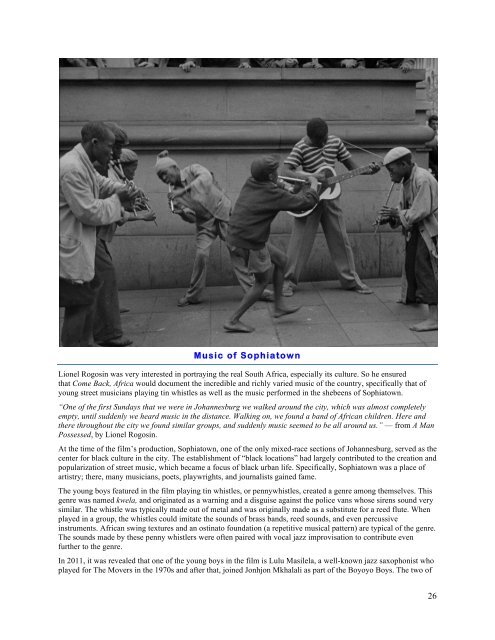Come Back Africa Press Kit - Get a Free Blog
Come Back Africa Press Kit - Get a Free Blog
Come Back Africa Press Kit - Get a Free Blog
Create successful ePaper yourself
Turn your PDF publications into a flip-book with our unique Google optimized e-Paper software.
Music of Sophiatown<br />
Lionel Rogosin was very interested in portraying the real South <strong>Africa</strong>, especially its culture. So he ensured<br />
that <strong>Come</strong> <strong>Back</strong>, <strong>Africa</strong> would document the incredible and richly varied music of the country, specifically that of<br />
young street musicians playing tin whistles as well as the music performed in the shebeens of Sophiatown.<br />
“One of the first Sundays that we were in Johannesburg we walked around the city, which was almost completely<br />
empty, until suddenly we heard music in the distance. Walking on, we found a band of <strong>Africa</strong>n children. Here and<br />
there throughout the city we found similar groups, and suddenly music seemed to be all around us.” — from A Man<br />
Possessed, by Lionel Rogosin.<br />
At the time of the film’s production, Sophiatown, one of the only mixed-race sections of Johannesburg, served as the<br />
center for black culture in the city. The establishment of “black locations” had largely contributed to the creation and<br />
popularization of street music, which became a focus of black urban life. Specifically, Sophiatown was a place of<br />
artistry; there, many musicians, poets, playwrights, and journalists gained fame.<br />
The young boys featured in the film playing tin whistles, or pennywhistles, created a genre among themselves. This<br />
genre was named kwela, and originated as a warning and a disguise against the police vans whose sirens sound very<br />
similar. The whistle was typically made out of metal and was originally made as a substitute for a reed flute. When<br />
played in a group, the whistles could imitate the sounds of brass bands, reed sounds, and even percussive<br />
instruments. <strong>Africa</strong>n swing textures and an ostinato foundation (a repetitive musical pattern) are typical of the genre.<br />
The sounds made by these penny whistlers were often paired with vocal jazz improvisation to contribute even<br />
further to the genre.<br />
In 2011, it was revealed that one of the young boys in the film is Lulu Masilela, a well-known jazz saxophonist who<br />
played for The Movers in the 1970s and after that, joined Jonhjon Mkhalali as part of the Boyoyo Boys. The two of<br />
26


